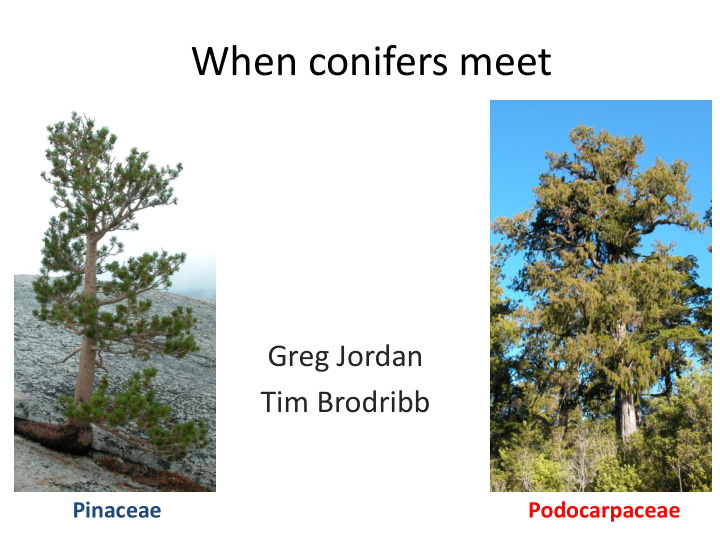



When conifers meet Greg Jordan Tim Brodribb Pinaceae Podocarpaceae
North versus South Equator Species richness in Pinaceae equal area grid cells (2° latitude) Equator Podocarpaceae
Dispersal limitation? • evidence for "rapid" dispersal of some Podocarpaceae [at least] – long history at high southern latitudes [≥ 150 million years] – appeared in SE Asia ≤ 20 million years
or niche constraints? • Physiology – podocarps hate frost, dry climates & fire – pines hate closed forest • is this true now? • was it true in the past?
Pinaceae and Podocarpaceae occupy different climate spaces now 120 140 100 120 Number of species Number of species 100 80 80 60 60 40 40 20 20 0 0 -38 -34 -30 -26 -22 -18 -14 -10 -6 -2 2 6 10 14 18 22 Mean minimum temperature of the cold month Precipitation of the driest quarter (log scale) (°C) Podocarpaceae are absent from Podocarpaceae occupy wetter very frosty climates climates than Pinaceae
Two regions of overlap Equator Pinaceae Equator Podocarpaceae
Similar contrasts in the regions of overlap 40 60 35 50 Number of species Number of species 30 40 25 30 20 15 20 10 10 5 0 0 -38 -34 -30 -26 -22 -18 -14 -10 -6 -2 2 6 10 14 18 22 Precipitation of the driest quarter (log scale) Mean minimum temperature of the cold month (°C) The contrasting climates are not just because of the different climates in the SH & NH
Was this true in the past? • Ancestral state reconstructions? • Other ways?
extinction and directional selection in conifers poses problems for ancestral state reconstruction 1,2 • conifer phylogenies clades with very long stems • extensive fossil evidence of climate driven extinction 1 Crisp MD, Cook LG. 2011. Cenozoic extinctions account for the low diversity of extant gymnosperms compared with angiosperms. New Phytologist 192 : 997-1009. 2 Nagalingum NS, Marshall CR, Quental TB, Rai HS, Little DP, Mathews S. 2011. Recent synchronous radiation of a living fossil. Science 334 : 796-799.
Phylogenetic endemism • weights diversity according to past selection – upweights rare old clades – i.e. ones that have been selected against...
species richness for all conifers Phylogenetic endemism for all conifers
As a sign of past processes • rare old clades are presumably rare because of past selection • these clades tend to retain ancient, unfavoured physiology • high phylogenetic endemism relative to species richness can indicate ancestral states
Phylogenetic endemism in climate space (Pinaceae vs Podocarpaceae) 120 Number of species 100 80 60 Both clades show a mode in phylogenetic endemism at a cold 40 month minimum temperature of 20 ~0°C 0 130 Phylogenetic endemism 110 Divergent radiations: 90 Pinaceae into frosty places 70 Podocarpaceae into tropical 50 rainforest 30 10 -10 -38 -34 -30 -26 -22 -18 -14 -10 -6 -2 2 6 10 14 18 22 Mean cold month minimum temperature (°C)
Summer temperature (proximity to tree line) 180 160 Nu ber of species 140 120 100 80 60 40 Podocarpaceae moved into 20 warmer climates? 0 140 Phylogenetic endemism 120 Pinaceae moved into colder 100 climates 80 60 40 20 0 6 8 10 12 14 16 18 20 22 24 26 28 30 32 mean temperature of the warmest month
Dry climates 140 Number of species 120 100 80 Podocarpaceae have not 60 changed – always wet 40 20 0 Pinaceae were always drier than 120 Phylogenetic endemism 100 Podocarpaceae, but have 80 radiated further into dry climates 60 40 20 0 0 4 16 36 64 100 144 196 256 324 400 dry month precipitation (mm)
Mean annual precipitation 160 140 Number of species 120 100 80 60 40 Both clades have moved to 20 drier climates, but especially 0 Pinaceae 160 Phylogenetic endemism 140 120 100 80 60 40 20 0 75 100 200 500 1000 2000 5000 mean annual precipitation (mm)
Overall • Podocarpaceae and Pinaceae are strongly ecologically differentiated • This appears to have always been the case – niche conservatism – especially for Podocarpaceae • Pinaceae constrained by the Equator • Phylogenetic endemism tells us about the past, not just the present
Recommend
More recommend